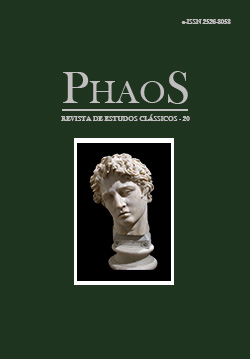Abstract
In one of the fragments of the Gerioneid of Estheire, the Sun, after crossing the skies to the west, returns at night by the Ocean to his home, where a mother, wife and children await him. The identity of the sun's mother is obscure; according to the Hesiodic tradition, the Night is its progenitor, but it dwells, according to Hesiod himself, in the West. This article suggests a solution regarding the identity and abode of the mother of the Sun based on indo-European comparative poetics. Material of the oldest Indo-European Islamic tradition, the Rig Veda, leads us to assume that Aesthesicorum, in this particular, preserves an archaism that, in Greece, is only indirectly atone in one of the Homeric Hymns.
References
CAMPANILE, E. Histoire et préhistoire d’une formule poétique indo-européenne. Études Indo-Europénnes 6, p. 21-24, 1987 (= Saggi di linguistica comparativa e ricostruzione culturale. Pisa/Roma: Istituti Editoriali e Poligrafici Internazionali, p. 175-178, 1999).
DAVIES, M. e FINGLASS, P. J. Stesichorus: The Poems. Edited with Introduction, Translation, and Commentary. Cambridge: Cambridge University Press, 2014.
FRAENKEL, E. Aeschylus. Agamemnon. Edited with a Commentary (vol. II). Oxford: Oxford University Press, 1962
GARCÍA-RAMÓN, J. L. Homme comme force, force d’homme: un motif onomastique et l’étymologie du vieil irlandais gus. In: PINAULT, G.-J.; PETIT, D. (ed.) La langue poétique indo-européenne. Actes du Colloque de travail de la Société des Études Indo-Européennes. Paris, 22-24 octobre 2003. Leuven/Paris: Peeters, p. 79-93, 2006.
MACEDO, J. M. Two Divine Epithets in Stesichorus: Poseidon ἱπποκέλευθος and Aphrodite ἠπιόδωρος. Classical Philology 111, p. 1-18, 2016.
MACEDO, J. M. A Stylistic Remark on the Disjunctive Clause in Sophocles’ Trachiniae 100-101. Hermes 145, p. 491-498, 2017.
NORDEN, E. Agnostos Theos. Untersuchungen zur Formengeschichte religiöser Rede. Leipzig/Berlim: Teubner, 1929.
PRIVITERA, G. A. Pindaro: Le Istmiche. Milão, Mondadori, 1982.
WACKERNAGEL, J. Zum homerischen Dual. Zeitschrift für vergleichende Sprachforschung 23, p. 302-310, 1877.
WACKERNAGEL, J. Altindische Grammatik. II,1 – Einleitung zur Wortlehre. Nominalkomposition. Göttingen: Vandenhoek & Ruprecht, 1905.
WEST, M. L. Hesiod: Theogony. Edited with Prolegomena and Commentary. Oxford: Oxford University Press, 1966.
WEST, M. L. Indo-European Poetry and Myth. Oxford: Oxford University Press, 2007.

This work is licensed under a Creative Commons Attribution-NonCommercial-ShareAlike 4.0 International License.


